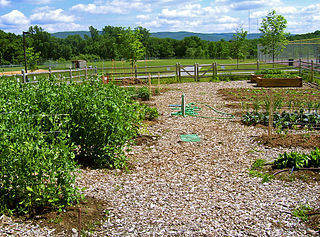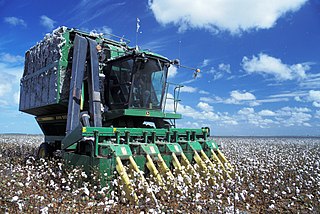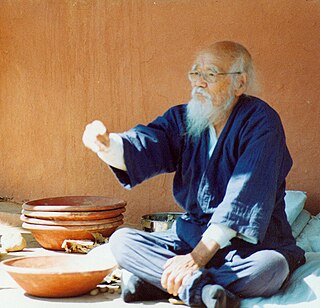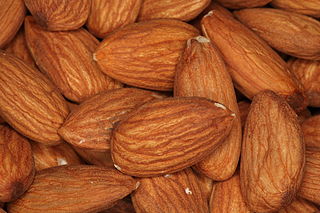Related Research Articles

A farmer is a person engaged in agriculture, raising living organisms for food or raw materials. The term usually applies to people who do some combination of raising field crops, orchards, vineyards, poultry, or other livestock. A farmer might own the farmed land or might work as a laborer on land owned by others, but in most developed economies, a farmer is usually a farm owner, while employees of the farm are known as farm workers, or farmhands. However, in other older definitions a farmer was a person who promotes or improves the growth of plants, land or crops or raises animals by labor and attention.

Organic farming is an agricultural system that uses fertilizers of organic origin such as compost manure, green manure, and bone meal and places emphasis on techniques such as crop rotation and companion planting. It originated early in the 20th century in reaction to rapidly changing farming practices. Certified organic agriculture accounts for 70 million hectares globally, with over half of that total in Australia. Organic farming continues to be developed by various organizations today. Biological pest control, mixed cropping and the fostering of insect predators are encouraged. Organic standards are designed to allow the use of naturally-occurring substances while prohibiting or strictly limiting synthetic substances. For instance, naturally-occurring pesticides such as pyrethrin and rotenone are permitted, while synthetic fertilizers and pesticides are generally prohibited. Synthetic substances that are allowed include, for example, copper sulfate, elemental sulfur and Ivermectin. Genetically modified organisms, nanomaterials, human sewage sludge, plant growth regulators, hormones, and antibiotic use in livestock husbandry are prohibited. Organic farming advocates claim advantages in sustainability, openness, self-sufficiency, autonomy and independence, health, food security, and food safety.

The following outline is provided as an overview of and topical guide to organic gardening and farming:
Eliot Coleman is an American farmer, author, agricultural researcher and educator, and proponent of organic farming. His book The New Organic Grower is important reading for organic farmers, especially market gardeners. He served for two years as Executive Director of the International Federation of Organic Agriculture Movements (IFOAM), and was an advisor to the U.S. Department of Agriculture during its 1979–80 study, Report and Recommendations on Organic Farming, a document that formed the basis for today's legislated National Organic Program (2002) in the U.S.
Biodynamic agriculture is a form of alternative agriculture similar to organic farming, but it includes various pseudo-scientific and esoteric concepts of Rudolf Steiner (1861–1925). Initially developed in 1924, it was the first of the organic agriculture movements. It treats soil fertility, plant growth, and livestock care as ecologically interrelated tasks, emphasizing spiritual and mystical perspectives.

The Salinas Valley is one of the major valleys and most productive agricultural regions in California. It is located west of the San Joaquin Valley and south of San Francisco Bay and the Santa Clara Valley.

An herb farm is usually a farm where herbs are grown for market sale. There is a case for the use of a small farm being dedicated to herb farming as the smaller farm is more efficient in terms of manpower usage and value of the crops on a per acre basis. In addition, the market for herbs is not as large as the more commercial crops, providing the justification for the small-scale herb farm. Herbs may be for culinary, medicinal or aromatic use, and sold fresh-cut or dried. Herbs may also be grown for their essential oils or as raw material for making herbal products. Many businesses calling themselves an herb farm sell potted herb plants for home gardens. Some herb farms also have gift shops, classes, and sometimes offer food for sale. In the United States, some herb farms belong to trade associations.

Mechanised agriculture is the process of using agricultural machinery to mechanise the work of agriculture, greatly increasing farm worker productivity. In modern times, powered machinery has replaced many farm jobs formerly carried out by manual labour or by working animals such as oxen, horses and mules.

Traditional farming was the original type of agriculture, and has been practiced for thousands of years. All traditional farming is now considered to be "organic farming" although at the time there were no known inorganic methods. For example, forest gardening, a fully organic food production system which dates from prehistoric times, is thought to be the world's oldest and most resilient agroecosystem. The industrial revolution introduced inorganic methods, most of which were not well developed and had serious side effects. An organic movement began in the 1940s as a reaction to agriculture's growing reliance on synthetic fertilizers and pesticides. The history of this modern revival of organic farming dates back to the first half of the 20th century at a time when there was a growing reliance on these new synthetic, non-organic methods.

Driscoll's is a California-based seller of fresh strawberries and other berries. It is a fourth-generation family business that has been in the Reiter and Driscoll families since the late 1800s. In 2017, it controlled roughly one-third of the $6 billion U.S. berry market. Headquartered in Watsonville, California, Driscoll's develops proprietary breeds of berries and then licenses them exclusively through approved growers.

Intensive crop farming is a modern industrialized form of crop farming. Intensive crop farming's methods include innovation in agricultural machinery, farming methods, genetic engineering technology, techniques for achieving economies of scale in production, the creation of new markets for consumption, patent protection of genetic information, and global trade. These methods are widespread in developed nations.

The role of agriculture in the Bolivian economy in the late 1980s expanded as the collapse of the tin industry forced the country to diversify its productive and export base. Agricultural production as a share of GDP was approximately 23 percent in 1987, compared with 30 percent in 1960 and a low of just under 17 percent in 1979. The recession of the 1980s, along with unfavorable weather conditions, particularly droughts and floods, hampered output. Agriculture employed about 46 percent of the country's labor force in 1987. Most production, with the exception of coca, focused on the domestic market and self-sufficiency in food. Agricultural exports accounted for only about 15 percent of total exports in the late 1980s, depending on weather conditions and commodity prices for agricultural goods, hydrocarbons, and minerals.
The Student Sustainable Farm at Rutgers is located at Rutgers' Horticultural Research Station in New Brunswick, New Jersey, on the G. H. Cook campus of Rutgers University.

Natural farming, also referred to as "the Fukuoka Method", "the natural way of farming" or "do-nothing farming", is an ecological farming approach established by Masanobu Fukuoka (1913–2008). Fukuoka, a Japanese farmer and philosopher, introduced the term in his 1975 book The One-Straw Revolution. The title refers not to lack of effort, but to the avoidance of manufactured inputs and equipment. Natural farming is related to fertility farming, organic farming, sustainable agriculture, agroecology, agroforestry, ecoagriculture and permaculture, but should be distinguished from biodynamic agriculture.
Florida Certified Organic Growers and Consumers, also known as Florida Organic Growers or FOG, is a non-profit organization founded in 1987. It is classified as a 501(c) corporation. One of the main facets of FOG is Quality Certification Services, a program that extends through 30 states and 14 countries. FOG is also concerned with community outreach and education in order to promote healthy organic lifestyles and social equity.
Joseph Miles Reiter is an American farmer and entrepreneur, and the CEO of Driscoll's, Inc., a global agribusiness specializing in fresh year-round berry production.

Jean-Martin Fortier is a Québécois farmer, author, educator and advocate for ecological, human-scale and economically-viable sustainable agriculture.

Agriculture is a significant sector in California's economy, producing nearly $50 billion in revenue in 2018. There are more than 400 commodity crops grown across California, including a significant portion of all fruits, vegetables, and nuts for the United States. In 2017, there were 77,100 unique farms and ranches in the state, operating across 25.3 million acres of land. The average farm size was 328 acres, significantly less than the average farm size in the U.S. of 444 acres.
Wish Farms is a Plant City, Florida based year-round supplier of strawberries, blueberries, raspberries and blackberries. It is a third-generation family owned and operated company that began in 1922.
Will Bonsall is an American author, seed saver and veganic farmer who lives in Maine. He is a regular speaker about seed saving, organic farming and veganic farming.
References
- 1 2 3 "Strawberry grower shows how to make a profit without poisons". grist.org. 26 April 2011. Retrieved 8 August 2011.
- 1 2 3 "Interview with Jim Cochran". UC Santa Cruz Library Digital Collections. Retrieved 8 August 2011.
- ↑ "Meet the Organic Strawberry Grower Who Welcomed the Union to His Farm". takepart.org. 1 October 2014.
- 1 2 3 Samuel Fromartz (2005). Organic Inc.: Natural Foods and How They Grew . Harcourt. ISBN 978-0-15-603242-1.
- ↑ Krishna V. Subbarao and J. C. Hubbard (1996). "Interactive Effects of Broccoli Residue and Temperature on Verticillium dahliae Microsclerotia in Soil and on Wilt in Cauliflower". Phytopathology. Vol. 86, no. 12.
{{cite news}}: CS1 maint: uses authors parameter (link)